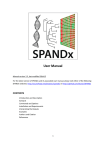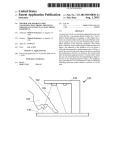Download M5 simulator system TDT4260 Computer Architecture User
Transcript
M5 simulator system
TDT4260 Computer Architecture
User documentation
Last modified: January 20, 2014
Contents
1 Introduction
2
1.1
Overview . . . . . . . . . . . . . . . . . . . . . . . . . . . . .
2
1.2
Chapter outlines . . . . . . . . . . . . . . . . . . . . . . . . .
2
2 Installing and running M5
4
2.1
Download . . . . . . . . . . . . . . . . . . . . . . . . . . . . .
4
2.2
Installation . . . . . . . . . . . . . . . . . . . . . . . . . . . .
4
2.2.1
Linux . . . . . . . . . . . . . . . . . . . . . . . . . . .
4
2.2.2
VirtualBox disk image . . . . . . . . . . . . . . . . . .
5
2.3
Build . . . . . . . . . . . . . . . . . . . . . . . . . . . . . . . .
5
2.4
Run . . . . . . . . . . . . . . . . . . . . . . . . . . . . . . . .
5
2.4.1
CPU2000 benchmark tests . . . . . . . . . . . . . . . .
6
2.4.2
Running M5 with custom test programs . . . . . . . .
7
Submitting the prefetcher for benchmarking . . . . . . . . . .
8
2.5
3 The prefetcher interface
10
3.1
Memory model . . . . . . . . . . . . . . . . . . . . . . . . . .
10
3.2
Interface specification . . . . . . . . . . . . . . . . . . . . . .
10
3.3
Using the interface . . . . . . . . . . . . . . . . . . . . . . . .
12
3.3.1
14
Example prefetcher . . . . . . . . . . . . . . . . . . . .
4 Statistics
15
5 Debugging the prefetcher
17
5.1
m5.debug and trace flags . . . . . . . . . . . . . . . . . . . . .
17
5.2
GDB . . . . . . . . . . . . . . . . . . . . . . . . . . . . . . . .
17
5.3
Valgrind . . . . . . . . . . . . . . . . . . . . . . . . . . . . . .
18
1
Chapter 1
Introduction
You are now going to write your own hardware prefetcher, using a modified
version of M5, an open-source hardware simulator system. This modified
version presents a simplified interface to M5’s cache, allowing you to concentrate on a specific part of the memory hierarchy: a prefetcher for the
second level (L2) cache.
1.1
Overview
This documentation covers the following:
• Installing and running the simulator
• Machine model and memory hierarchy
• Prefetcher interface specification
• Using the interface
• Testing and debugging the prefetcher on your local machine
• Submitting the prefetcher for benchmarking
• Statistics
1.2
Chapter outlines
The first chapter gives a short introduction, and contains an outline of the
documentation.
2
The second chapter starts with the basics: how to install the M5 simulator.
There are two possible ways to install and use it. The first is as a standalone VirtualBox disk-image, which requires the installation of VirtualBox.
This is the best option for those who use Windows as their operating system
of choice. For Linux enthusiasts, there is also the option of downloading a
tarball, and installing a few required software packages.
The chapter then continues to walk you through the necessary steps to
get M5 up and running: building from source, running with command-line
options that enables prefetching, running local benchmarks, compiling and
running custom test-programs, and finally, how to submit your prefetcher
for testing on a computing cluster.
The third chapter gives an overview over the simulated system, and describes its memory model. There is also a detailed specification of the
prefetcher interface, and tips on how to use it when writing your own
prefetcher. It includes a very simple example prefetcher with extensive comments.
The fourth chapter contains definitions of the statistics used to quantitatively measure prefetchers.
The fifth chapter gives details on how to debug prefetchers using advanced
tools such as GDB and Valgrind, and how to use trace-flags to get detailed
debug printouts.
3
Chapter 2
Installing and running M5
2.1
Download
Download the modified M5 simulator from the PfJudgeβ website.
2.2
2.2.1
Installation
Linux
Software requirements (specific Debian/Ubuntu packages mentioned in parentheses):
• 3.4.6 <= g++ <= 4.4
• Python and libpython >= 2.4 (python and python-dev)
• Scons > 0.98.1 (scons)
• SWIG >= 1.3.31 (swig)
• zlib (zlib1g-dev)
• m4 (m4)
To install all required packages in one go, issue instructions to apt-get:
sudo apt-get install g++ python-dev scons swig zlib1g-dev m4
The simulator framework comes packaged as a gzipped tarball. Start the adventure by unpacking with tar xvzf framework.tar.gz. This will create
a directory named framework.
4
2.2.2
VirtualBox disk image
If you do not have convenient access to a Linux machine, you can download
a virtual machine with M5 preconfigured. You can run the virtual machine
with VirtualBox, which can be downloaded from http.//www.virtualbox.
org.
The virtual machine is available as a zip archive from the PfJudgeβ website. After unpacking the archive, you can import the virtual machine into
VirtualBox by selecting “Import Appliance” in the file menu and opening
“Prefetcher framework.ovf”. The root password of the virtual machine is
“user” (no quotation marks). It will be required if you want to run sudo
commands.
2.3
Build
M5 uses the scons build system: scons -j2 ./build/ALPHA SE/m5.opt
builds the optimized version of the M5 binaries.
-j2 specifies that the build process should built two targets in parallel. This
is a useful option to cut down on compile time if your machine has several
processors or cores.
The included build script compile.sh encapsulates the necessary build commands and options.
Since the g++ version is rather old, you can also compile the simulator
on kongull. Use module load scons && module load swig to load the
necessary programs (check with module list whether they were loaded)
and then compile by invoking the build script.
2.4
Run
Before running M5, it is necessary to specify the architecture and parameters
for the simulated system. This is a nontrivial task in itself. Fortunately
there is an easy way: use the included example python script for running
M5 in syscall emulation mode, m5/config/example/se.py. When using
a prefetcher with M5, this script needs some extra options, described in
Table 2.1.
For an overview of all possible options to se.py, do
./build/ALPHA SE/m5.opt configs/example/se.py --help
When combining all these options, the command line will look something
like this:
5
Option
Description
--detailed
Detailed timing simulation
--caches
Use caches
--l2cache
Use level two cache
--l2size=1MB
Level two cache size
--prefetcher=policy=proxy
Use the C-style prefetcher interface
--prefetcher=on access=True
Have the cache notify the prefetcher
on all accesses, both hits and misses
--cmd
The program (an Alpha binary) to run
Table 2.1: Basic se.py command line options.
./build/ALPHA SE/m5.opt configs/example/se.py --detailed
--caches --l2cache --l2size=1MB --prefetcher=policy=proxy
--prefetcher=on access=True
This command will run se.py with a default program, which prints out
“Hello, world!” and exits. To run something more complicated, use the
--cmd option to specify another program. See subsection 2.4.2 about crosscompiling binaries for the Alpha architecture. Another possibility is to run
a benchmark program, as described in the next section.
2.4.1
CPU2000 benchmark tests
The test prefetcher.py script can be used to evaluate the performance of
your prefetcher against the SPEC CPU2000 benchmarks. It runs a selected
suite of CPU2000 tests with your prefetcher, and compares the results to
some reference prefetchers.
The per-test statistics that M5 generates are written to
output/<testname-prefetcher>/stats.txt. The statistics most relevant
for hardware prefetching are then filtered and aggregated to a stats.txt
file in the framework base directory.
See chapter 4 for an explanation of the reported statistics.
Since programs often do some initialization and setup on startup, a sample
from the start of a program run is unlikely to be representative for the whole
program. It is therefore desirable to begin the performance tests after the
program has been running for some time. To save simulation time, M5 can
resume a program state from a previously stored checkpoint. The prefetcher
framework comes with checkpoints for the CPU2000 benchmarks taken after
109 instructions.
6
It is often useful to run a specific test to reproduce a bug. To run the
CPU2000 tests outside of test prefetcher.py, you will need to set the
M5 CPU2000 environment variable. If this is set incorrectly, M5 will give the
error message “Unable to find workload”. To export this as a shell variable,
do
export M5 CPU2000=lib/cpu2000
Near the top of test prefetcher.py there is a commented-out call to
dry run(). If this is uncommented, test prefetcher.py will print the
command line it would use to run each test. This will typically look like
this:
m5/build/ALPHA SE/m5.opt --remote-gdb-port=0 -re
--outdir=output/ammp-user m5/configs/example/se.py
--checkpoint-dir=lib/cp --checkpoint-restore=1000000000
--at-instruction --caches --l2cache --standard-switch
--warmup-insts=10000000 --max-inst=10000000 --l2size=1MB
--bench=ammp --prefetcher=on access=true:policy=proxy
This uses some additional command line options, these are explained in
Table 2.2.
Option
Description
--bench=ammp
Run one of the SPEC CPU2000 benchmarks.
--checkpoint-dir=lib/cp
The directory where program checkpoints are stored.
--at-instruction
Restore at an instruction count.
--checkpoint-restore=n
The instruction count to restore at.
--standard-switch
Warm up caches with a simple CPU model,
then switch to an advanced model to gather statistics.
--warmup-insts=n
Number of instructions to run warmup for.
--max-inst=n
Exit after running this number of instructions.
Table 2.2: Advanced se.py command line options.
2.4.2
Running M5 with custom test programs
If you wish to run your self-written test programs with M5, it is necessary to
cross-compile them for the Alpha architecture. The easiest way to achieve
this is to download the precompiled compiler-binaries provided by crosstool
from the M5 website. Install the one that fits your host machine best (32
or 64 bit version). When cross-compiling your test program, you must use
the -static option to enforce static linkage.
7
To run the cross-compiled Alpha binary with M5, pass it to the script with
the --cmd option. Example:
./build/ALPHA SE/m5.opt configs/example/se.py --detailed
--caches --l2cache --l2size=512kB --prefetcher=policy=proxy
--prefetcher=on access=True --cmd /path/to/testprogram
2.5
Submitting the prefetcher for benchmarking
First of all, you need a user account on the PfJudgeβ web pages. The
teaching assistant in TDT4260 Computer Architecture will create one for
you. You must also be assigned to a group to submit prefetcher code or
view earlier submissions.
Sign in with your username and password, then click “Submit prefetcher”
in the menu. Select your prefetcher file, and optionally give the submission
a name. This is the name that will be shown in the highscore list, so choose
with care. If no name is given, it defaults to the name of the uploaded file.
If you check “Email on complete”, you will receive an email when the results
are ready. This could take some time, depending on the cluster’s current
workload.
When you click “Submit”, a job will be sent to the Kongull cluster, which
then compiles your prefetcher and runs it with a subset of the CPU2000
tests. You are then shown the “View submissions” page, with a list of all
your submissions, the most recent at the top.
When the prefetcher is uploaded, the status is “Uploaded”. As soon as it is
sent to the cluster, it changes to “Compiling”. If it compiles successfully, the
status will be “Running”. If your prefetcher does not compile, status will
be “Compile error”. Check “Compilation output” found under the detailed
view.
When the results are ready, status will be “Completed”, and a score will be
given. The highest scoring prefetcher for each group is listed on the highscore
list, found under “Top prefetchers” in the menu. Click on the prefetcher
name to go a more detailed view, with per-test output and statistics.
If the prefetcher crashes on some or all tests, status will be “Runtime error”.
To locate the failed tests, check the detailed view. You can take a look at
the output from the failed tests by clicking on the “output” link found after
each test statistic.
To allow easier exploration of different prefetcher configurations, it is possible to submit several prefetchers at once, bundled into a zipped file. Each
.cc file in the archive is submitted independently for testing on the cluster.
The submission is named after the compressed source file, possibly prefixed
with the name specified in the submission form.
8
There is a limit of 50 prefetchers per archive.
9
Chapter 3
The prefetcher interface
3.1
Memory model
The simulated architecture is loosely based on the DEC Alpha Tsunami
system, specifically the Alpha 21264 microprocessor. This is a superscalar,
out-of-order (OoO) CPU which can reorder a large number of instructions,
and do speculative execution.
The L1 prefetcher is split in a 32kB instruction cache, and a 64kB data
cache. Each cache block is 64B. The L2 cache size is 1MB, also with a cache
block size of 64B. The L2 prefetcher is notified on every access to the L2
cache, both hits and misses. There is no prefetching for the L1 cache.
The memory bus runs at 400MHz, is 64 bits wide, and has a latency of 30ns.
3.2
Interface specification
The interface the prefetcher will use is defined in a header file located at
prefetcher/interface.hh. To use the prefetcher interface, you should
include interface.hh by putting the line #include "interface.hh" at
the top of your source file.
#define
BLOCK SIZE
MAX QUEUE SIZE
MAX PHYS MEM SIZE
Value
64
100
228 − 1
Description
Size of cache blocks (cache lines) in bytes
Maximum number of pending prefetch requests
The largest possible physical memory address
Table 3.1: Interface #defines.
NOTE: All interface functions that take an address as a parameter blockalign the address before issuing requests to the cache.
10
Function
Description
void prefetch init(void)
Called before any memory access to let the
prefetcher initialize its data structures
void prefetch access(AccessStat stat)
Notifies the prefetcher about a cache access
void prefetch complete(Addr addr)
Notifies the prefetcher about a prefetch load
that has just completed
Table 3.2: Functions called by the simulator.
Function
Description
void issue prefetch(Addr addr)
Called by the prefetcher to initiate a prefetch
int get prefetch bit(Addr addr)
Is the prefetch bit set for addr?
int set prefetch bit(Addr addr)
Set the prefetch bit for addr
int clear prefetch bit(Addr addr)
Clear the prefetch bit for addr
int in cache(Addr addr)
Is addr currently in the L2 cache?
int in mshr queue(Addr addr)
Is there a prefetch request for addr in
the MSHR (miss status holding register) queue?
int current queue size(void)
Returns the number of queued prefetch requests
void DPRINTF(trace, format, ...)
Macro to print debug information.
trace is a trace flag (HWPrefetch),
and format is a printf format string.
Table 3.3: Functions callable from the user-defined prefetcher.
AccessStat member
Description
Addr pc
The address of the instruction that caused the access
(Program Counter)
Addr mem addr
The memory address that was requested
Tick time
The simulator time cycle when the request was sent
int miss
Whether this demand access was a cache hit or miss
Table 3.4: AccessStat members.
11
The prefetcher must implement the three functions prefetch init,
prefetch access and prefetch complete. The implementation may be
empty.
The function prefetch init(void) is called at the start of the simulation
to allow the prefetcher to initialize any data structures it will need.
When the L2 cache is accessed by the CPU (through the L1 cache), the function void prefetch access(AccessStat stat) is called with an argument
(AccessStat stat) that gives various information about the access.
When the prefetcher decides to issue a prefetch request, it should call
issue prefetch(Addr addr), which queues up a prefetch request for the
block containing addr.
When a cache block that was requested by issue prefetch arrives from
memory, prefetch complete is called with the address of the completed
request as parameter.
Prefetches issued by issue prefetch(Addr addr) go into a prefetch request
queue. The cache will issue requests from the queue when it is not fetching
data for the CPU. This queue has a fixed size (available as MAX QUEUE SIZE),
and when it gets full, the oldest entry is evicted. If you want to check the
current size of this queue, use the function current queue size(void).
3.3
Using the interface
Start by studying interface.hh. This is the only M5-specific header file
you need to include in your header file. You might want to include standard
header files for things like printing debug information and memory allocation. Have a look at what the supplied example prefetcher (a very simple
sequential prefetcher) to see what it does.
If your prefetcher needs to initialize something, prefetch init is the place
to do so. If not, just leave the implementation empty.
You will need to implement the prefetch access function, which the cache
calls when accessed by the CPU. This function takes an argument,
AccessStat stat, which supplies information from the cache: the address
of the executing instruction that accessed cache, what memory address was
access, the cycle tick number, and whether the access was a cache miss. The
block size is available as BLOCK SIZE. Note that you probably will not need
all of this information for a specific prefetching algorithm.
If your algorithm decides to issue a prefetch request, it must call the
issue prefetch function with the address to prefetch from as argument.
The cache block containing this address is then added to the prefetch request
12
queue. This queue has a fixed limit of MAX QUEUE SIZE pending prefetch requests. Unless your prefetcher is using a high degree of prefetching, the
number of outstanding prefetches will stay well below this limit.
Every time the cache has loaded a block requested by the prefetcher,
prefetch complete is called with the address of the loaded block.
Other functionality available through the interface are the functions for getting, setting and clearing the prefetch bit. Each cache block has one such
tag bit. You are free to use this bit as you see fit in your algorithms. Note
that this bit is not automatically set if the block has been prefetched, it
has to be set manually by calling set prefetch bit. set prefetch bit on
an address that is not in cache has no effect, and get prefetch bit on an
address that is not in cache will always return false.
When you are ready to write code for your prefetching algorithm of choice,
put it in prefetcher/prefetcher.cc. When you have several prefetchers,
you may want to to make prefetcher.cc a symlink.
The prefetcher is statically compiled into M5. After prefetcher.cc has
been changed, recompile with ./compile.sh. No options needed.
13
3.3.1
Example prefetcher
/*
* A sample prefetcher which does sequential one-block lookahead.
* This means that the prefetcher fetches the next block _after_ the one that
* was just accessed. It also ignores requests to blocks already in the cache.
*/
#include "interface.hh"
void prefetch_init(void)
{
/* Called before any calls to prefetch_access. */
/* This is the place to initialize data structures. */
DPRINTF(HWPrefetch, "Initialized sequential-on-access prefetcher\n");
}
void prefetch_access(AccessStat stat)
{
/* pf_addr is now an address within the _next_ cache block */
Addr pf_addr = stat.mem_addr + BLOCK_SIZE;
/*
* Issue a prefetch request if a demand miss occured,
* and the block is not already in cache.
*/
if (stat.miss && !in_cache(pf_addr)) {
issue_prefetch(pf_addr);
}
}
void prefetch_complete(Addr addr) {
/*
* Called when a block requested by the prefetcher has been loaded.
*/
}
14
Chapter 4
Statistics
This chapter gives an overview of the statistics by which your prefetcher is
measured and ranked.
IPC instructions per cycle. Since we are using a superscalar architecture,
IPC rates > 1 is possible.
Speedup Speedup is a commonly used proxy for overall performance when
running benchmark tests suites.
speedup =
execution timeno prefetcher
IP Cwith prefetcher
=
execution timewith prefetcher
IP Cno prefetcher
Good prefetch The prefetched block is referenced by the application before it is replaced.
Bad prefetch The prefetched block is replaced without being referenced.
Accuracy Accuracy measures the number of useful prefetches issued by
the prefetcher.
good prefetches
acc =
total prefetches
Coverage How many of the potential candidates for prefetches were actually identified by the prefetcher?
cov =
good prefetches
cache misses without prefetching
Identified Number of prefetches generated and queued by the prefetcher.
15
Issued Number of prefetches issued by the cache controller. This can
be significantly less than the number of identified prefetches, due to
duplicate prefetches already found in the prefetch queue, duplicate
prefetches found in the MSHR queue, and prefetches dropped due to
a full prefetch queue.
Misses Total number of L2 cache misses.
Degree of prefetching Number of blocks fetched from memory in a single
prefetch request.
Harmonic mean A kind of average used to aggregate each benchmark
speedup score into a final average speedup.
Havg =
1
x1
+
1
x2
n
+ ... +
16
1
xn
n
= Pn
1
i=1 xi
Chapter 5
Debugging the prefetcher
5.1
m5.debug and trace flags
When debugging M5 it is best to use binaries built with debugging support
(m5.debug), instead of the standard build (m5.opt). So let us start by
recompiling M5 to be better suited to debugging:
scons -j2 ./build/ALPHA SE/m5.debug.
To see in detail what’s going on inside M5, one can specify enable trace
flags, which selectively enables output from specific parts of M5. The most
useful flag when debugging a prefetcher is HWPrefetch. Pass the option
--trace-flags=HWPrefetch to M5:
./build/ALPHA SE/m5.debug --trace-flags=HWPrefetch [...]
Warning: this can produce a lot of output! It might be better to redirect
stdout to file when running with --trace-flags enabled.
5.2
GDB
The GNU Project Debugger gdb can be used to inspect the state of the
simulator while running, and to investigate the cause of a crash. Pass GDB
the executable you want to debug when starting it.
gdb --args m5/build/ALPHA SE/m5.debug --remote-gdb-port=0
-re --outdir=output/ammp-user m5/configs/example/se.py
--checkpoint-dir=lib/cp --checkpoint-restore=1000000000
--at-instruction --caches --l2cache --standard-switch
--warmup-insts=10000000 --max-inst=10000000 --l2size=1MB
--bench=ammp --prefetcher=on access=true:policy=proxy
You can then use the run command to start the executable.
17
Some useful GDB commands:
run <args>
Restart the executable with the given command line arguments.
run
Restart the executable with the same arguments as last time.
where
Show stack trace.
up
Move up stack trace.
down
Move down stack frame.
print <expr>
Print the value of an expression.
help
Get help for commands.
quit
Exit GDB.
GDB has many other useful features, for more information you can consult
the GDB User Manual at http://sourceware.org/gdb/current/onlinedocs/
gdb/.
5.3
Valgrind
Valgrind is a very useful tool for memory debugging and memory leak detection. If your prefetcher causes M5 to crash or behave strangely, it is useful
to run it under Valgrind and see if it reports any potential problems.
By default, M5 uses a custom memory allocator instead of malloc. This will
not work with Valgrind, since it replaces malloc with its own custom memory allocator. Fortunately, M5 can be recompiled with NO FAST ALLOC=True
to use normal malloc:
scons NO FAST ALLOC=True ./m5/build/ALPHA SE/m5.debug
To avoid spurious warnings by Valgrind, it can be fed a file with warning
suppressions. To run M5 under Valgrind, use
valgrind --suppressions=lib/valgrind.suppressions
./m5/build/ALPHA SE/m5.debug [...]
Note that everything runs much slower under Valgrind.
18
































![j:j_"Xt$l"j:]:":,lg]:"r/Human Resources have been duty - e](http://vs1.manualzilla.com/store/data/005657435_1-26d97049bf04f0fd92265d73e45a9ab3-150x150.png)







